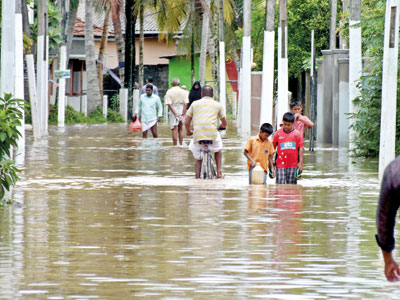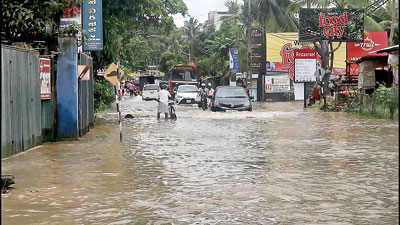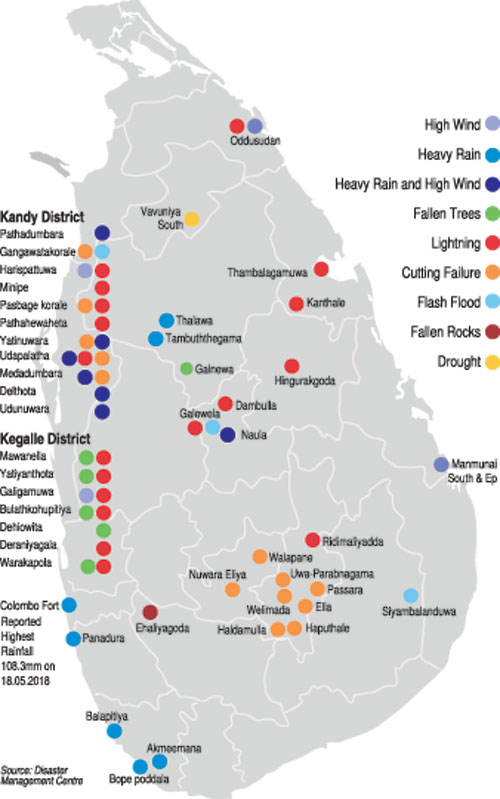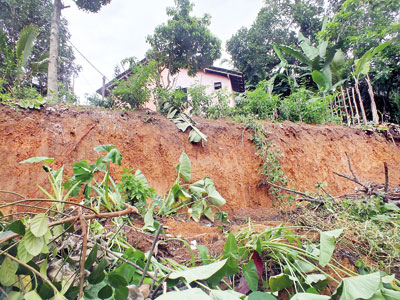News
Brace for month of monsoon mayhem
Weather extremes ranging from high-intensity rainfall triggering flash floods, landslides and rock-falls, lightning strikes, sea surges and gusty winds toppling trees are expected as experts warn of the coming days causing mayhem in highly-populated districts.

Flood waters in Beruwala. Pic Thusitha K de Silva
The Disaster Management Ministry is making swift preparations to face the oncoming south-west monsoon that is to strike the Galle, Matara, Hambantota, Ratnapura, Kegalle, Colombo, Kalutara, Gampaha, Kandy, Puttalam and Badulla districts.
Disaster Management Centre (DMC) Deputy Director (Early Warning) Pradeep Kodippilli said the DMC had organised an emergency preparedness and coordination meeting over possible flash floods in urban areas and landslides in the hill country.
The discussions on the monsoon’s intensity, potential impact and response preparedness involved stakeholders such as the DMC, district secretariats, the Meteorology Department, National Building Research Organisation (NBRO), Electricity Board, Fisheries Minsitry, the armed forces and the police.
Disasters triggered by monsoonal rains last year claimed 219 lives and caused more than Rs.70 billion in damage from floods and landslides. In 2016, 93 people lost their lives and the damages amounted to Rs. 99 billion.
Disaster Management Minister Duminda Dissanayake said this week that authorities had been instructed to immediately clear drains and canals, cut down trees and branches that can cause risk to lives and property, and to be prepared for the early evacuation of people settled in high-risk hill areas and river banks.
The minister said Disaster Management Units were equipped with boats and lifesaving jackets and arrangements had been made to provide prepared food and dry rations in case of emergency. He said temporary shelters had also been identified.
According to the Meteorology Department, the present showery weather is a mix of the tail-end of the inter-monsoon (evening thundershowers), the beginning of the south-west monsoon (heavy rain to the south-western parts of the country and the central hills) and atmospheric disturbances in the Indian Ocean.
Director (Forecasting) Anusha Warnasooriya said the current conditions would affect all parts of the country, with heavy rainfall of about 100mm expected in the Western, Central, Sabaragamuwa, Uva and North-Western provinces and in the Ampara, Batticaloa, Galle and Matara districts.
Motorists are advised to be cautious in misty conditions expected in the Sabaragamuwa and Central provinces during the mornings.

Galle, kahaduwawatte junction. Pic by Sirangika Lokukarawite
Coastal areas, especially in the south and west, will experience sea surges. Very strong gusty winds upto 70-80 kmph and rough seas can be expected during thundershowers, the Meteorology Department warned.
“This condition will last a few days. However, we are expecting the full onset of the south-west monsoon by Tuesday (May 22). This monsoon is accompanied by heavy rains to south-west parts of the country,” the department said.
Fishermen and Navy personeel are advised to take precautions in the rough seas expected.
The NBRO sent out early warnings, asking the public to be watchful about the possibility of landslides, slope failures, rock falls, and ground subsidence.
“All mountainous areas, man-made cut slopes and roads within the Passara, Lunugala, Badulla, Hali Ela, Bandarawela, Ella, Haputale and Haldummulla divisional secretariat divisions and surrounding areas are at risk,” the warning stated.
NBRO Director of the Landslide Research and Risk Management Division, R.M.S. Bandara, warned about travel in these high-risk areas, especially during evenings when showers are heavy.
“The NBRO is working 24/7 and will immediately announce evacuation and road closures if heavy rainfall is reported in high-risk areas and there is a risk for those living in the areas and motorists,” Mr. Bandara said.
Heavy rains on May 12 resulted in 1920 families being displaced in Galle, District Secretary Pradeep Ratnayake said.
The Kadawathsathara, Akmeemana, Bope, Poddala and Balapitiya areas in Galle have suffered damage from the intense rains, with more than 150 houses damaged from rock falls.
Passara, Welimada, Haputale and Haldumulla were severely hit by landslides with more than 500 people affected and about 75 houses damaged. Displaced families and families from risk areas are settled in the Galkanda and Bandaraeliya Tamil schools.
Kandy recorded incidents of damage from strong winds, flash flood, high wind, lightning and heavy rains in Pathadumbara, Gangawatakorale, Harispattuwa, Minipe, Pasbage Korale, Pathahewaheta, Yatinuwara,Udapalatha, Medadumbara, Deltota and Udunuwara, with more than 93 families affected, and a death reported from Pasbage Korale.
In Eheliyagoda, Ratnapura a rock-fall was reported, and nine families in a high-risk area were rehoused in temporary shelters.
In the Kalutara district, Panadura experienced heavy rains with 157 families affected.
Galewela in Matale district experienced flash floods last week while earlier this month several families from Naaula were affected by strong winds and heavy showers.
There were flash floods from heavy rains in Siyambalanduwa in the Moneragala district.
Very heavy rain in the Kegalle district caused incidents of trees falling, flash floods, lightning strikes, strong winds in Mawanella Yatiyantota, Galigamuwa, Bulathkohupitiya, Dehiowita, Deraniyagala and Warakapola.
Police reported five deaths from lightning this month in Mullaitivu, Vavuniya, Minneriya, Kantale and Kurunegala.
A number of spill gates were also opened last week, with warnings sent to people living downstream.
Professor S.A. Norbert of Colombo University’s Department of Geography said the damage from the south-west monsoon is severe as it affects the country’s most populated districts.
“The past 3-5 weeks had extreme warm weather, and it is possible to have high-intensity rains just after warm weather. This phenomena can induce flash floods, especially in the south-western part of the country,” said Prof. Norbert, who added that global warming will have an added impact on extreme weather changes.
He said local authorities should look into drainage systems to prevent floods in cities caused by intense rainfall.
“The south-western winds come from the vast Indian Ocean and the moisture-laden clouds travel to the central hills and release vast amounts of water. This will result in raised water levels in inland water reserves,” he added.

An earth slip at the tsunami village in Payagala. Pic by Sarath Siriwardhene

Kalutara: Food being prepared for families displaced by floods. Pic by Sunil Thanthiriarachchi

